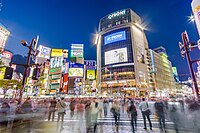
Photo from wikipedia
Tehran, the capital of Iran, is the largest and most populous city in Iran, which is of great importance due to its large population and abundant infrastructure. One of the… Click to show full abstract
Tehran, the capital of Iran, is the largest and most populous city in Iran, which is of great importance due to its large population and abundant infrastructure. One of the most critical issues in this city is its need for resilience against all kinds of threats, including natural hazards, because its development was not based on territorial geography. In other words, in developing this 700 square kilometer area, attention has yet to be paid to its different zones. Different zones include the mountains, Shemiranat’s alluvial cone area, the Tehran plain, etc. Main and minor faults, surface and underground water resources of the land, differences in formations between various parts of the land, the microclimate of the land in its multiple aspects, local and synoptic air currents, etc., have not been influential in urban development. The most crucial goal of this study is to identify and screen natural hazards in Tehran to improve this city’s resilience by introducing a novel integrated MCDM method based on ANP and The Combined Compromise Solution method with Maximum Variance (MV-CoCoSo). Therefore, to increase the strength of Tehran against these disasters, the natural hazards of Tehran must first be identified and ranked. In this regard, practical criteria for evaluating Tehran’s resilience were identified using library resources and the formation of expert groups. Then, using the ANP method, the comparative weightings of these effective criteria was investigated. Based on the results obtained, the disaster consequence criterion had the highest importance with a weight of 0.4361, followed by the disaster severity scale criterion with a weight of 0.2371, and the secondary threat possibility criterion (with a weight of 0.1232) was ranked third. Finally, using the MV-CoCoSo method, the natural hazards of Tehran city were classified based on the evaluated criteria. Tehran City’s three significant disasters were earthquakes, floods, and landslides. In addition, two experiments were designed to assess the robustness of the research methodology.
Journal Title: Mathematics
Year Published: 2023
Link to full text (if available)
Share on Social Media: Sign Up to like & get
recommendations!